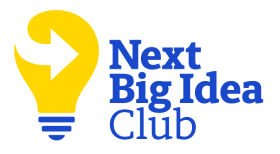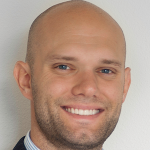Dean Carignan leads AI innovations within Microsoft Research and at Microsoft’s Office of the Chief Scientist. JoAnn Garbin was Director of Innovation in Microsoft’s cloud business, where she guided her team developing billion-dollar opportunities such as the Regenerative Datacenter of the Future.
What’s the big idea?
Over the past 50 years, Microsoft has evolved from a scrappy startup to a global powerhouse. Its journey is packed with successes and setbacks—each carrying valuable lessons. Dean Carignan and JoAnn Garbin used their insider access to create a guide for all those who want the right mindset and tools for mastering the art of innovation.
Below, co-authors Dean Carignan and JoAnn Garbin share five key insights from their new book, The Insider’s Guide to Innovation at Microsoft. Listen to the audio version—read by Dean and JoAnn—in the Next Big Idea App.
1. Innovation starts with discovery, not luck.
Innovation doesn’t emerge from thin air, even when it seems to. Innovation begins with deliberate exploration: stepping back, asking new questions, and finding new perspectives. However, the modern corporation is set up to move forward quickly, consistently, and predictably. How often do we make time for discovery?
At Microsoft, divergent thinking is not left to chance. It is baked into the company’s structure and operations. Microsoft Research is tasked with pushing boundaries as its mission, while the annual Garage Hackathon gives every employee the opportunity to step away from their day jobs, collaborate across organizations, and learn by doing. Even in product-centric teams like the Developer Division, leadership dedicates small teams to pursue promising hypotheses full-time. They recognize that discovery doesn’t fit between meetings and can’t be prioritized part-time.
Divergent thinking requires time, space, and focus. Whether it is an innovation retreat like Think Week or a full-time dedicated team, make room to diverge and learn before you converge on answers. The best innovators aren’t necessarily the fastest—they’re the ones who spend more time exploring.
2. Boundary crossers keep innovation flowing.
Innovation isn’t a straight line. It’s loopy: iterative, adaptive, and full of hand-offs. To navigate this complexity, you need boundary crossers, meaning people who connect dots, bridge teams, and ensure that nothing slips through the cracks.
At Microsoft, boundary crossers were pivotal in all cases. In Cognitive Services, they connected people from seven lines of business to overcome long-standing AI challenges. In Xbox, innovation flourished because the design, engineering, and business teams worked hand-in-hand.
“Innovation happens at intersections.”
Boundary crossers thrive in the in-between spaces, connecting the big picture with finer details. Whether you are hiring or assigning roles, seek those who excel at working across disciplines. Innovation happens at intersections, and boundary crossers ensure the process flows.
3. Innovation is more than technology.
Innovation isn’t always about shiny new tech. In fact, it’s not even mostly about shiny new tech. Real breakthroughs come from rethinking how value is delivered through systems, processes, and relationships.
Take Microsoft Office. Transitioning to a subscription model wasn’t just a technological pivot; it fundamentally changed how the team measured success, redefining metrics around user engagement and satisfaction rather than scope, schedule, and budget. In the process, they also reorganized to elevate Design to be an equal partner with Engineering, bringing them together at the start of every project. Other breakthroughs include Xbox Game Pass, which redefined the gaming business model to be a streaming service. And Visual Studio Code’s “develop in the open” ethos took community engagement to a new level, one that has made them the most popular developer tool in the market.
Innovation is needed in every aspect of business to achieve results like Microsoft’s. It’s not just about what you deliver but how you deliver it. To innovate effectively, reimagine the systems and structures that bring your ideas to life.
4. Innovation success starts with feelings.
Innovation, by definition, requires change, and people don’t really like change. Long before they rationally decide to adopt your new thing, they must want to adopt it. People change not because it makes sense but because it feels right or necessary. Tapping into how people feel plays a pivotal role in the success of any innovation.
Consider Bing’s turnaround. The team had been losing to Google for years despite multiple strategy shifts. Finally, Satya Nadella introduced a mission shift that reignited the team’s passion, rallying them to succeed against the odds and become the tip of the spear of Microsoft’s AI revolution. Conversely, the failed Xbox One launch cost the team hard-earned trust with the core gaming community, and that took years to rebuild. Longtime fans felt betrayed by the emphasis on TV and music features; they complained that Xbox no longer cared about gaming.
“Innovation success not only starts with emotion but runs on it.”
Passion, betrayal, trust, and caring. Time and again, we have found that innovation success not only starts with emotion but runs on it.
The book introduces a framework for connecting and leading with emotion to guide behavior change. Based on decades of behavioral science research, it maps how people move from being unaware to becoming advocates. The key is meeting people where they are, building trust, and bringing them along step-by-step. Technology evolves quickly, but people take their time. You need them to head in your direction when they are ready to move.
5. Responsible innovation is an opportunity if you make it so.
At Microsoft, teams throughout the company transform corporate responsibility challenges into opportunities by shifting the related requirements from outputs to inputs in the innovation process. We call this approach shift left.
Microsoft embeds considerations like privacy, security, and accessibility from the very beginning of product development. The same principle applies to responsible AI and sustainability. This allows us to design out the risks and design in additional benefits.
Solving issues by design not only saves time and costs but also strengthens customer relationships. Move fast, but don’t break the things that matter. By embedding responsibility into your processes, you’ll build stronger innovations and deeper trust.
To listen to the audio version read by co-authors Dean Carignan and JoAnn Garbin, download the Next Big Idea App today:










